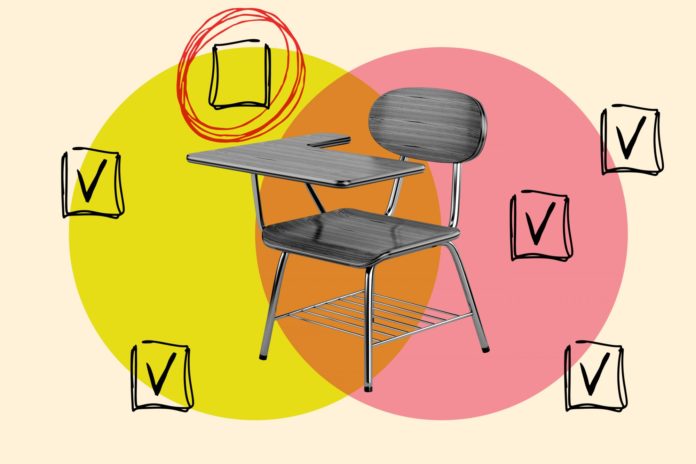
As a mom to 5-year-old twins who entered kindergarten this year, I'm navigating the public school system for the very first time as a parent. That's an intimidating proposition for anyone, full of unexpected challenges. Among them? An intense feeling of attendance pressure.
More than halfway into the school year, my kids have each been absent about eight times—including four days apiece in a single week for protracted high fevers (up to 104!). Other reasons for their absences included active vomiting, and a skin infection the pediatrician described as "highly contagious."
On each of those days, I had received what felt like an absolute onslaught of automated phone calls and emails from the school district. And when both kids were out at the same time, multiply those messages by two. They included the language: "High academic achievement requires regular attendance" and "We expect your child will achieve an attendance rate above 95 percent." When I'm home mopping up vomit and trying to soothe feverish children while multitasking my professional responsibilities, these messages can feel downright accusatory.
Of course, all parents understand—and do not debate—the importance of getting our kids to school. It's critical for their education. But surely the reasons parents have for keeping our kids home are equally valid. Sometimes it's both necessary for our own kids' health, and also to protect other kids (and teachers) from contagious illnesses.
I feel fortunate that my kids' ailments have been generally run of the mill. But I can only imagine the pressure and pain this causes for parents of children dealing with acute or chronic health issues, visible or invisible.
That's why it's time to rethink the whole concept of such a high-pressure attendance paradigm. And while we're at it, let's ditch the whole concept of publicly rewarding students—whose parents are largely responsible for the attendance decision-making—for their "perfect" attendance in front of their peers. In fact, research in 2019 found that giving attendance awards for students in sixth through twelfth grade didn't improve behavior and even decreased subsequent attendance.
Why is There so Much Attendance Pressure?
Aside from kids getting an education, there's another reason why many schools may push hard for the average daily attendance. "It's one of the main funding sources for all schools," says author, educator, and former school administrator Kimberly A. Morrow, who was responsible for her school's attendance incentive program in Apple Valley Unified School District in California.
That average daily attendance metric, or ADA, is the driver behind the school getting finances that pay for staff, resources, and other educational programs. Several states, including California, Illinois, Kentucky, Mississippi, Missouri, New York, and Texas, use a school district's ADA to determine its funding. Many other states base it on enrollment or the number of students enrolled in each school and district. "This is a huge issue for the school districts, staff, and students who have no say in how the state has chosen to fund its schools," says Morrow.
ADA is typically calculated by "the total number of days of student attendance divided by the total number of days in the regular school year," according to EdSource.org. Students who are "chronically absent," or missing about 15 or more days, can cost school systems millions of dollars.
You might be wondering, then: Can school districts sometimes lose sight of the individual student's current situation in an effort to provide for the larger student population? "My answer is yes they can, and, unfortunately, oftentimes we do," says Morrow.
How to Ease the Attendance Pressure on Parents
To help mitigate the negative effects of the messaging on families, Morrow says schools can make things easier on parents. As a K-12 principal, she did that by inviting families to a meet and greet with the director of child welfare and attendance and the superintendent of schools at the start of each year.
"Parents learned to report their child's absence immediately to avoid the robo calls," she says. "They learned what constituted an excused, unexcused, and verified absence by the state, the most effective way to notify the school and, most importantly, how students can benefit academically and socially from being in school every day."
But that aside, she acknowledges that it's just not always possible nor advantageous to public health to get kids to school every single day. And schools should institute incentive programs that take more students into account. "I support incentive programs that recognize improvement in attendance as well as redemption," says Morrow. "Not only should we recognize students with perfect attendance and no tardies, we should also recognize those whose attendance and tardies have improved over the course of the school year."
Such redemption programs, she says, allow students with valid health excuses to make up absences and tardies after school or in Saturday school. It will help the students "feel less discriminated against and work hard to be in school when they feel well."
It's important to balance the pressure all parties may face, says Danna Greenberg, Ph.D., professor of management at Babson College and co-author of the book Maternal Optimism, whose research focuses on the psychological and career effects of employed parents. And to do that, communication between home and school is key.
"Forging open parent-teacher communication is one way you can balance the pressure you as a parent feel when you are caught in this institutional dilemma," says Dr. Greenberg. "For elementary school children, beyond calling the sick line, reach out to your child's teacher to address the tension between missing school and illness. At the middle school and high school level, you can connect with your child's guidance counselor. You and the teacher or guidance counselor can work to create a customized solution that balances these competing pressures and best meets the needs of your child and your unique situation."
In the end, notes Dr. Greenberg, "perfect attendance is not a marker of learning, nor may it be the best mechanism for achieving learning and growth for students with different needs and abilities."
Indeed, the notion of "perfect" attendance should be viewed as variable based on a child's wellness weighed against their educational needs. And parents—like me—might be relieved to acknowledge that the push for zero absences is driven in part by the almighty dollar, and not exclusively a matter of the child's best interest, or even the best interest of the public health.
So, as the school continues to do its job of applying pressure when students are absent or tardy, let's allow ourselves to relax through that pressure, as long as we know we're doing the best for their health balanced against their education.













